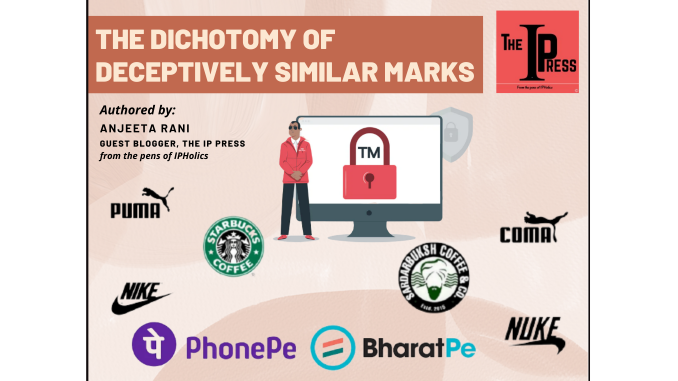
A BRIEF INTRODUCTION
Trademarks like any other intellectual property are considered to be the property of the individual or corporation in whose it has been registered. In India, the trademarks are accorded their due protection under the Trademarks Act, 1999. In order to protect the infringement of a trademark, Section 11(1) of the act prohibits the registration of a trademark if it is so identical or similar to an already existing trademark that it may create confusion in the minds of the general public.
Although the act does not specifically define an identical or similar mark, it defines ‘deceptively similar mark’ under Section 2(1)(h) of the act as a mark that is deceptively similar to another mark to the extent that it nearly resembles the other mark which is likely to deceive or cause confusion”. As such, there is no straight-jacket formula prescribed either by the legislation or the judiciary to identify a deceptively similar mark. However, with every particular case, courts across the world have evolved several principles based on which an infringement suit is decided. While there are certain principles to guide the courts, each suit needs to be adjudged from a new lens as per the facts and circumstances of the case.
This gap often leads to contrasting judgments. The same can be seen through the recent dispute of digital payment platform PhonePe and BharatPe dealt by the Delhi High Court and the trademark infringement suit of ‘Khadi’ adjudicated by the WIPO Arbitration & Mediation Centre. The adjudicating bodies in these cases are different, however, the guiding principles considered by them to decide upon a trademark infringement suit is pertinent to be detailed out.
PHONEPE PRIVATE LIMITED VS. EZY SERVICES & ANR. (BHARATPE)
In this case, the online payment service providing platform PhonePe alleged that the use of the word “BharatPe” by the defendants is an infringement of its trademark. While analysing the case, the Hon’ble Court took into consideration the protection accorded to composite marks under Section 17 of the act which deals with the effects of registration in cases where several parts of a trademark have been registered separately. The Court here emphasised that Section 17 provides exclusivity to such registered parts of the mark, however in the present case, the plaintiff’s mark was a composite mark and was registered as a whole, therefore, no exclusivity can be claimed over the parts distinctly.
THE PIANOTIST TEST IN CONSIDERATION
The court applied the Pianotist Test while comparing the competing marks wherein the common part does is not the decisive factor rather the composite mark as a whole is to be seen in cases of goods of similar description. The court laid down five principles based on the merits of the present case. It held that –
- a registered trademark cannot be dissected to claim exclusivity over it.
- An infringement can be claimed only if the part of the registered mark is dominant or its essential feature.
- There is no exclusivity over generic or descriptive marks.
- Misspelling the descriptive word or mark cannot allow for the applicability of this principle.
- However, if the descriptive or generic mark has acquired distinctiveness or secondary meaning then in such cases, this principle won’t be applicable.
COURT’S DECISION
Applying these principles to the present case, the court held that the term “Pay” is a descriptive term that has been misspelt as “Pe” in the plaintiff’s composite mark, therefore no infringement can be claimed on part of the registered trademark.
KHADI & VILLAGE INDUSTRIES COMMISSION VS. OM SOFT SOLUTION
In this case, the dispute arose over the domain name “urbankhadiclub.com” owned by Om Soft Solution as infringing the registered domain names of the complainant. The complaint was filed under paragraph 4 of Uniform Domain Name Dispute Resolution Policy (hereinafter “Policy”). The complainant, Khadi & Village Industries Commission, has registered several domain names which include the terms “Khadi” and “Khadi India”. The complainant alleged that its registered trademark “Khadi” has acquired goodwill among the public by virtue of its long and continuous use and due to the widespread promotions and publicity accorded to the mark, therefore it is highly likely to confuse the minds of the general public that the respondent is associated with the complainant’s business.
However, the respondent contended that “Khadi” is a generic term in India and no protection can be claimed for the said term as a trademark nor does the disputed mark “Urban Khadi Club” has any phonetic or visual connotation causing confusion.
WIPO CENTRE’S OBSERVATIONS
While analysing the facts of this case, the WIPO Arbitration & Mediation Centre took into consideration three factors as provided under paragraph 4 (a) of the policy –
- The domain name is identical or confusingly similar to the registered trademark
- The opposing party has any rights or legitimate interests in the disputed domain name
- The disputed domain name has been registered and used in bad faith.
Analysing the facts of the case in the shade of above-mentioned factors, the centre observed that the complainant has in its name registered several domain names with the word “khadi”, therefore, the respondent’s use of term “khadi” in its domain name is confusingly similar to complainant’s domain name. Neither the complainant has authorised the respondent to use the disputed name nor he has earned any reputation by the use of the disputed domain, thus, the respondent has acquired no legitimate right to use the domain name. Further, the centre observed that the disputed domain was registered and used in bad faith because the mark already had a goodwill in the market and respondent used it for businesses competitive to the complainant.
WIPO CENTRE’S DECISION
Taking into consideration the following factors, the Centre held that the mark is confusingly similar to the registered trademarks of the complainant as it has several marks and domain names registered with the term “Khadi”, therefore, the disputed domain name shall confuse the public to associate it with the complainant’s mark and as such ordered the disputed domain name to be transferred to the complainant.
CONCLUSION
In both cases, the respective adjudicating bodies considered the identical similarity of the disputed mark in the context of the prior registered marks. Even though in each case the dispute was over a generic term in the mark, the decision varied because of the facts and circumstances of the case. While the Delhi HC court applied the anti-dissection rule, the WIPO Centre accorded importance to the goodwill and prior use of the mark. Albeit, both the bodies follow the different legislations in considering IP matters and as such do not influence on each other, the bottom line is that there is no one size fits all formula. The courts have also, time and again, iterated that the test applied in each case depends upon the circumstances of those cases and that the precedents are only relevant to apply the tests and not to the facts altogether.

Anjeeta Rani
Guest Blogger
I am a final year law student pursuing B.A. LL.B. (Hons.) from Chanakya National Law University
The concept of “deceptively similar marks” presented in this article resonates deeply with us. As the article rightly points out, the lack of a clear-cut definition for such marks creates uncertainty. This can be particularly challenging for printers like us, who may be caught in the middle of potential trademark infringement disputes.